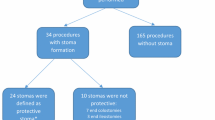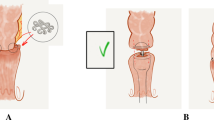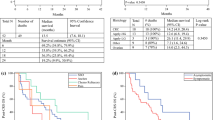Abstract
Introduction
Cytoreductive surgery with heated intraperitoneal chemotherapy (CRS/HIPEC) often includes stoma creation. We evaluated the indications, morbidity, and mortality associated with stoma creation and reversal after CRS/HIPEC.
Methods
Retrospective analysis of a prospective database of 1149 CRS–HIPEC procedures was performed. Patient demographics, type of malignancy, comorbidities, Clavien-graded morbidity, mortality, indications for stoma creation, and outcomes of subsequent reversal were abstracted.
Results
Sixteen percent (186/1149) of CRS/HIPEC procedures included stoma creation, whereas 1.1 % (11/963) of patients without initial stoma creation developed anastomotic leaks requiring stoma. Patients who required a stoma had worse preoperative performance status (ECOG 0/1: 77.2 vs. 86.1 %, p = 0.002), greater burden of disease (PCI 17.6 vs. 12.9, p < 0.0001), and were more likely to have R2 resections (74.5 vs. 48.8 %, p < 0.0001) than those without stoma creation. Stomas were intended to be permanent in 17.5 % (35/199). Of 164 patients with potentially reversible ostomies, only 26.2 % (43/164) underwent reversal. Disease progression (43/164, 26.2 %) and death (40/164, 24.3 %) most commonly precluded reversal. After reversal, 27.9 % (12/43) suffered a Clavien I/II morbidity, 27.9 % (12/43) suffered Clavien III/IV morbidity, and 30-day mortality was 4.7 % (2/43). Anastomotic leak occurred after 9 % (3/33) of ileostomy and 10 % (1/10) of colostomy reversals.
Conclusions
Stomas are more common among CRS/HIPEC patients with a high burden of disease and poor functional status. Reversal is uncommon and is associated with significant major morbidity. Preoperative counseling for those with high disease burden and poor functional status should include the risk of permanent stoma.

Similar content being viewed by others
References
Elias D, Gilly F, Boutitie F, Quenet F, Bereder J-M, Mansvelt B, et al. Peritoneal colorectal carcinomatosis treated with surgery and perioperative intraperitoneal chemotherapy: retrospective analysis of 523 patients from a multicentric French study. J Clin Oncol. 2010;28:63–8. doi:10.1200/JCO.2009.23.9285.
Chua TC, Moran BJ, Sugarbaker PH, Levine EA, Glehen O, Gilly FN, et al. Early- and long-term outcome data of patients with pseudomyxoma peritonei from appendiceal origin treated by a strategy of cytoreductive surgery and hyperthermic intraperitoneal chemotherapy. J Clin Oncol. 2012;30:2449–56. doi:10.1200/JCO.2011.39.7166.
Glehen O, Gilly FN, Boutitie F, Bereder JM, Quenet F, Sideris L, et al. Toward curative treatment of peritoneal carcinomatosis from nonovarian origin by cytoreductive surgery combined with perioperative intraperitoneal chemotherapy. Cancer. 2010;116:5608–18. doi:10.1002/cncr.25356.
Levine EA, Stewart IV JH, Shen P, Russell GB, Loggie BL, Votanopoulos KI. Intraperitoneal chemotherapy for peritoneal surface malignancy: experience with 1,000 patients. J Am Coll Surg. 2014;218:573–85. doi:10.1016/j.jamcollsurg.2013.12.013.
Shen P, Stewart JH, Levine EA. Cytoreductive surgery and hyperthermic intraperitoneal chemotherapy for peritoneal surface malignancy: overview and rationale. Curr Probl Cancer. 2009;33:125–41. doi:10.1016/j.currproblcancer.2009.06.003.
Dindo D, Demartines N, Clavien P-A. Classification of surgical complications: a new proposal with evaluation in a cohort of 6336 patients and results of a survey. Ann Surg. 2004;240:205–13.
Riss S, Chandrakumaran K, Dayal S, Cecil TD, Mohamed F, Moran BJ. Risk of definitive stoma after surgery for peritoneal malignancy in 958 patients: Comparative study between complete cytoreductive surgery and maximal tumor debulking. Eur J Surg Oncol. 2014. doi:10.1016/j.ejso.2014.09.002.
Shabbir J, Britton DC. Stoma complications: a literature overview. Colorectal Dis. 2010;12:958–64. doi:10.1111/j.1463-1318.2009.02006.x.
Gooszen DAW, Geelkerken RH, Hermans J, Lagaay MB, Gooszen HG. Quality of life with a temporary stoma. Dis Colon Rectum. 2000;43:650–5. doi:10.1007/BF02235581.
Kaiser AM, Israelit S, Klaristenfeld D, Selvindoss P, Vukasin P, Ault G, et al. Morbidity of ostomy takedown. J Gastrointest Surg. 2008;12:437–1. doi:10.1007/s11605-007-0457-8.
Bell C, Asolati M, Hamilton E, Fleming J, Nwariaku F, Sarosi G, et al. A comparison of complications associated with colostomy reversal versus ileostomy reversal. Am J Surg. 2005;190:717–20. doi:10.1016/j.amjsurg.2005.07.009.
Phang PT, Hain JM, Perez-Ramirez JJ, Madoff RD, Gemlo BT. Techniques and complications of ileostomy takedown. Am J Surg. 1999;177:463–6. doi:10.1016/S0002-9610(99)00091-4.
Mansfield SD, Jensen C, Phair AS, Kelly OT, Kelly SB. Complications of loop ileostomy closure: a retrospective cohort analysis of 123 patients. World J Surg. 2008;32:2101–6. doi:10.1007/s00268-008-9669-7.
Chow A, Tilney HS, Paraskeva P, Jeyarajah S, Zacharakis E, Purkayastha S. The morbidity surrounding reversal of defunctioning ileostomies: a systematic review of 48 studies including 6,107 cases. Int J Colorectal Dis. 2009;24:711–23. doi:10.1007/s00384-009-0660-z.
Acknowledgment
The authors thank the support of the Biostatistics and Bioinformatics Shared Resource, Comprehensive Cancer Center of Wake Forest University and NCI Cancer Center Support Grant P30 CA012197. Supported by: Wake Forest University Biostatistics shared resource NCI CCSG P30CA012197.
Disclosure
Nothing to disclose.
Author information
Authors and Affiliations
Corresponding author
Additional information
Accepted for oral presentation at 10th International Symposium on Regional Cancer Therapies, Clearwater, FL Feb 2015 and 10th Annual Academic Surgical Congress, Las Vegas, NV, Feb 2015.
Rights and permissions
About this article
Cite this article
Doud, A.N., Levine, E.A., Fino, N.F. et al. Stoma Creation and Reversal After Cytoreductive Surgery with Hyperthermic Intraperitoneal Chemotherapy. Ann Surg Oncol 23, 503–510 (2016). https://doi.org/10.1245/s10434-015-4674-1
Received:
Published:
Issue Date:
DOI: https://doi.org/10.1245/s10434-015-4674-1




